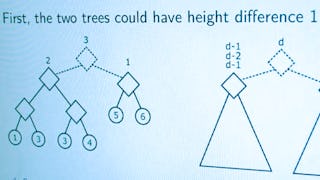Da jedes Smartphone und jeder Computer heute mit mehreren Prozessoren ausgestattet ist, wird die Verwendung funktionaler Ideen zur Erleichterung der parallelen Programmierung immer weiter verbreitet. In diesem Kurs lernen Sie die Grundlagen der parallelen Programmierung kennen, von der Aufgabenparallelität bis zur Datenparallelität. Insbesondere werden Sie sehen, wie sich viele vertraute Ideen aus der funktionalen Programmierung perfekt auf das Paradigma der Datenparallelität übertragen lassen. Wir beginnen mit den Grundlagen der effektiven Parallelisierung vertrauter Sammlungsoperationen und arbeiten uns zu parallelen Sammlungen vor, einer produktionsreifen datenparallelen Sammlungsbibliothek, die in der Scala-Standardbibliothek verfügbar ist. Während des gesamten Kurses werden wir diese Konzepte anhand mehrerer praktischer Beispiele anwenden, die Daten aus der realen Welt analysieren, z.B. beliebte Algorithmen wie k-means clustering. Lernergebnisse. Am Ende dieses Kurses werden Sie in der Lage sein: - über aufgaben- und datenparallele Programme nachzudenken, - gängige Algorithmen in einem funktionalen Stil auszudrücken und parallel zu lösen, - parallelen Code kompetent im Mikrobenchmarking zu testen, - Programme zu schreiben, die parallele Sammlungen effektiv nutzen, um Leistung zu erzielen Empfohlener Hintergrund: Sie sollten mindestens ein Jahr Programmiererfahrung haben. Ideal sind Java- oder C#-Kenntnisse, aber auch Erfahrungen mit anderen Sprachen wie C/C++, Python, Javascript oder Ruby sind ausreichend. Sie sollten mit der Kommandozeile etwas vertraut sein. Dieser Kurs sollte nach Functional Program Design in Scala belegt werden: https://www.coursera.org/learn/progfun2.

Läuft in 3 Tagen aus. Bringen Sie Ihre Karriere in Schwung mit 40 % Rabatt auf Kurse von Adobe, IBM und anderen Anbietern. Jetzt sparen.


Parallele Programmierung
Dieser Kurs ist Teil von Spezialisierung Funktionale Programmierung in Scala


Dozenten: Prof. Viktor Kuncak
60.735 bereits angemeldet
Bei  enthalten
enthalten
(1,844 Bewertungen)
Kompetenzen, die Sie erwerben
- Kategorie: Java
- Kategorie: Leistungsoptimierung
- Kategorie: Algorithmen
- Kategorie: Andere Programmiersprachen
- Kategorie: Funktionales Design
- Kategorie: Scala Programmierung
- Kategorie: Datenstrukturen
- Kategorie: Verteiltes Rechnen
Wichtige Details

Zu Ihrem LinkedIn-Profil hinzufügen
Erfahren Sie, wie Mitarbeiter führender Unternehmen gefragte Kompetenzen erwerben.

Erweitern Sie Ihre Fachkenntnisse
- Lernen Sie neue Konzepte von Branchenexperten
- Gewinnen Sie ein Grundverständnis bestimmter Themen oder Tools
- Erwerben Sie berufsrelevante Kompetenzen durch praktische Projekte
- Erwerben Sie ein Berufszertifikat zur Vorlage

In diesem Kurs gibt es 4 Module
Wir motivieren die parallele Programmierung und stellen die grundlegenden Konstrukte für die Erstellung paralleler Programme auf JVM und Scala vor. Beispiele wie Array-Norm und Monte-Carlo-Berechnungen veranschaulichen diese Konzepte. Wir zeigen, wie man den Aufwand und die Tiefe paralleler Programme abschätzen kann und wie man die Implementierungen einem Benchmarking unterzieht.
Das ist alles enthalten
9 Videos5 Lektüren3 Programmieraufgaben
Wir fahren mit Beispielen für parallele Algorithmen fort, indem wir eine parallele Mischsortierung vorstellen. Anschließend erklären wir, wie Operationen wie map, reduce und scan parallel berechnet werden können. Wir stellen Assoziativität als Schlüsselbedingung für die parallele Implementierung von reduce und scan vor.
Das ist alles enthalten
6 Videos2 Programmieraufgaben
Wir zeigen, wie datenparallele Operationen die Entwicklung von elegantem datenparallelem Code in Scala ermöglichen. Wir geben einen Überblick über die Hierarchie der parallelen Sammlungen, einschließlich der Eigenschaften von Splittern und Kombinierern, die Iteratoren und Builder aus dem sequentiellen Fall ergänzen.
Das ist alles enthalten
5 Videos2 Programmieraufgaben
Wir geben einen Einblick in die Interna von Datenstrukturen für paralleles Rechnen, was uns hilft zu verstehen, was unter der Haube von parallelen Sammlungen passiert.
Das ist alles enthalten
5 Videos2 Programmieraufgaben
Erwerben Sie ein Karrierezertifikat.
Fügen Sie dieses Zeugnis Ihrem LinkedIn-Profil, Lebenslauf oder CV hinzu. Teilen Sie sie in Social Media und in Ihrer Leistungsbeurteilung.
Dozenten

Mehr von Softwareentwicklung entdecken

École Polytechnique Fédérale de Lausanne
 Status: Kostenloser Testzeitraum
Status: Kostenloser TestzeitraumRice University
 Status: Kostenloser Testzeitraum
Status: Kostenloser TestzeitraumRice University
Warum entscheiden sich Menschen für Coursera für ihre Karriere?




Bewertungen von Lernenden
1.844 Bewertungen
- 5 stars
59,59 %
- 4 stars
28,14 %
- 3 stars
9,21 %
- 2 stars
2,22 %
- 1 star
0,81 %
Zeigt 3 von 1844 an
Geprüft am 31. März 2017
Its a very good course! perhaps the in the practice code, before jumping into the problems they can provide a couple of simple examples/questions such that the main ideas are learnt.
Geprüft am 16. Mai 2017
The assignment could be optimized and avoid to be more academic since it may make student lost focus and spend too much time on the question itself rather than the parallel programming
Geprüft am 22. Sep. 2016
Very good introduction to the topic. Examples and programming exercises were very good, although last assignment was visibly less polished than earlier ones.

Neue Karrieremöglichkeiten mit Coursera Plus
Unbegrenzter Zugang zu 10,000+ Weltklasse-Kursen, praktischen Projekten und berufsqualifizierenden Zertifikatsprogrammen - alles in Ihrem Abonnement enthalten
Bringen Sie Ihre Karriere mit einem Online-Abschluss voran.
Erwerben Sie einen Abschluss von erstklassigen Universitäten – 100 % online
Schließen Sie sich mehr als 3.400 Unternehmen in aller Welt an, die sich für Coursera for Business entschieden haben.
Schulen Sie Ihre Mitarbeiter*innen, um sich in der digitalen Wirtschaft zu behaupten.
Häufig gestellte Fragen
Der Zugang zu Vorlesungen und Aufgaben hängt von der Art Ihrer Einschreibung ab. Wenn Sie einen Kurs im Prüfungsmodus belegen, können Sie die meisten Kursmaterialien kostenlos einsehen. Um auf benotete Aufgaben zuzugreifen und ein Zertifikat zu erwerben, müssen Sie die Zertifikatserfahrung während oder nach Ihrer Prüfung erwerben. Wenn Sie die Prüfungsoption nicht sehen:
Der Kurs bietet möglicherweise keine Prüfungsoption. Sie können stattdessen eine kostenlose Testversion ausprobieren oder finanzielle Unterstützung beantragen.
Der Kurs bietet möglicherweise stattdessen die Option 'Vollständiger Kurs, kein Zertifikat'. Mit dieser Option können Sie alle Kursmaterialien einsehen, die erforderlichen Bewertungen abgeben und eine Abschlussnote erhalten. Dies bedeutet auch, dass Sie kein Zertifikat erwerben können.
Wenn Sie sich für den Kurs einschreiben, erhalten Sie Zugang zu allen Kursen der Specializations, und Sie erhalten ein Zertifikat, wenn Sie die Arbeit abgeschlossen haben. Ihr elektronisches Zertifikat wird Ihrer Erfolgsseite hinzugefügt - von dort aus können Sie Ihr Zertifikat ausdrucken oder zu Ihrem LinkedIn-Profil hinzufügen. Wenn Sie die Kursinhalte nur lesen und ansehen möchten, können Sie den Kurs kostenlos besuchen.
Wenn Sie ein Abonnement abgeschlossen haben, erhalten Sie eine kostenlose 7-tägige Testphase, in der Sie kostenlos kündigen können. Danach gewähren wir keine Rückerstattung, aber Sie können Ihr Abonnement jederzeit kündigen. Siehe unsere vollständigen Rückerstattungsbedingungen.
Weitere Fragen
Finanzielle Unterstützung verfügbar,


